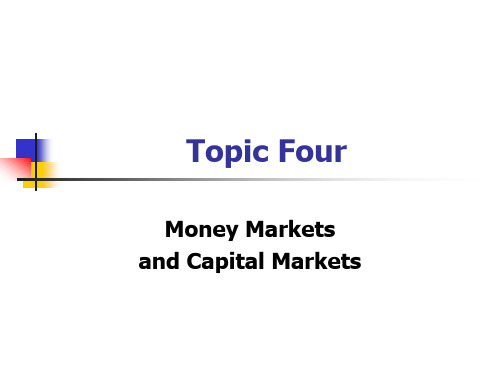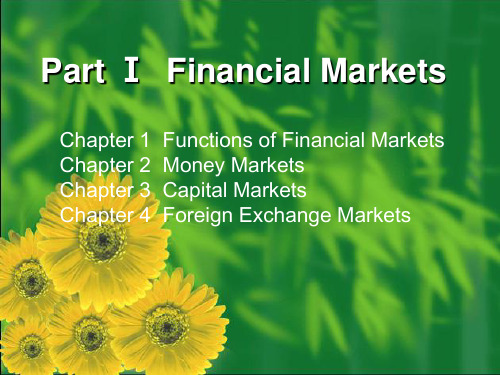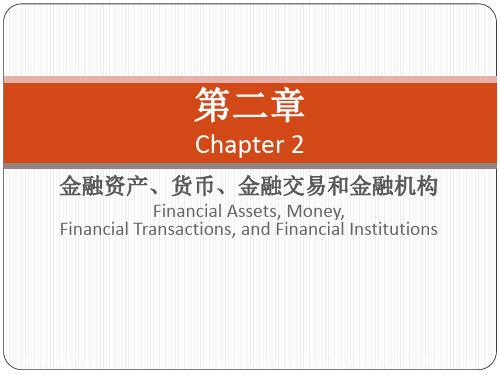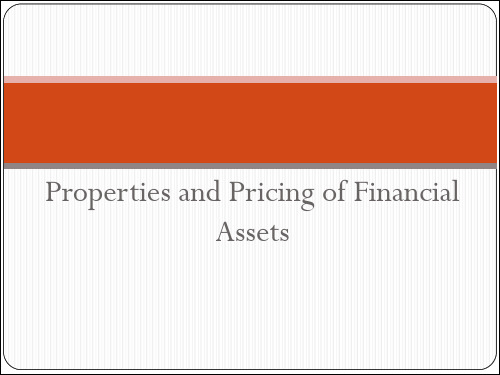金融市场学第四版1、2章英文讲义
金融市场学 Topic Four

凭证式国债与记帐式国债
柜台记账式国债: 商业银行柜台交易记账式国债的交易价格是由市场决定的,买 卖价格(净价)有可能高于或低于发行面值。当卖出价格高于买 入价格时,表明卖出者不仅获得了持有期间的国债利息,同时 还获得了部分价差收益;当卖出价格低于买入价格时,表明卖 出者虽然获得了持有期间的国债利息,但同时也付出了部分价 差损失。投资者购买记账式国债于到期前卖出,其价格不能预 知,因此,要承担一定的价格波动风险;而凭证式国债在发行 时就将持有不同时间提前兑取的分档利率做了规定,投资者提 前兑取凭证式国债所能获得的收益是提前预知的,不会随市场 利率的变动而变动,不必承担由于市场利率变动而带来的价格 风险。
Computing Bond Yields
Computing Bond Yields
Coupon Rate: the annual income that a bond investor receives expressed as a percent of the bond’s par value. It is of little use in determining a bond’s actual return. Current Yield: the current income from the bond as a percentage of its price. CY=C/P Promised Yield to Maturity(or YTM, 约定到期收益率): It indicates the fully compounded rate of return promised to an investor who buys the bond at prevailing prices.
金融英语课件Part1

Foreign exchange marker deals with the exchanges of different means of payment. These exchanges are necessary for international capital flows. As the relative values among different currencies (the exchange rates) will fluctuate according to economic and political circumstances of the currencies of the relative countries, international investors or financiers face exchange risks. To this end, foreign exchange markets provide services, such as forward transactions and foreign currency futures to eliminate such risks.
When an investor purchases the securities issued by ultimate borrowers (those who use the funds to invest in real assets), capital market operations for equities, bonds would fall largely into this category. When an investor chooses to invest in the obligations of financial intermediaries, which in turn lend the funds to those who invest in real assets, they are operations in money market for term deposits and loans, interbank transactions of such nature. The primary distinction between the two channels is that, in the first case, i.e. direct financing, the investor is faced directly with the credit risk of the issuer, while in the second case, i.e. financing through financial intermediation, a financial institution, such as a bank, interjects itself between users and providers of funds. Any analysis of the sector of money market dominated by financial intermediaries must be very much concerned with these financial institutions themselves (their policies, financial conditions and official regulatory environment) in addition to those factors governing the suppliers and users of funds. International financial transactions include purchases and sales of foreign currency, securities, gold bullion, and lending and borros
金融市场学讲义:第一章-PPT课件

•
•
• •
二、经济与金融市场 经济体系中的资金流量:生产——支付流动,在生产单位(政府、企业)和 消费单位(居民)之间循环进行。生产与收入的循环流动相互依存,没有止 境。 市场在经济体系中的作用:资源配置 市场三类型:要素市场、产品市场、金融市场 金融市场的特殊性:市场参与者之间的关系不是单纯买卖关系,还包括借贷 关系和委托代理关系;交易对象是货币资金;无形市场有成为主流的趋势。 金融市场的意义:是储蓄转化为投资的渠道。金融市场的高度发达,可以极 大的提高储蓄转化为投资的效率,推动经济发展。随着经济全球化和一体化, 出现了经济金融化的趋势,金融市场成为市场机制的主导和枢纽。这是一个 有利有弊的趋势。
第一节:金融市场的概念与功能
• • • • • • 一、金融市场的概念 金融市场是整个金融系统的核心 金融学三路径:宏观货币经济学;微观银行学或微观金融中介学;金融市场 学。 金融市场的定义:以市场方式买卖金融工具的场所。包括四层含义: 第一,它是金融工具进行交易的有形市场和无形市场的总和。 第二,它表现金融工具供应者和需求者之间的供求关系,反映资金盈余者和 资金短缺者之间的资金融通的过程。 第三,金融工具买卖或交易过程中产生的运行机制,是金融市场的深刻内涵 和自然发展,其中最核心的是价格机制。 第四,金融工具种类繁多,不同的金融工具交易有不同的市场,所以金融市 场又是一个由许多具体市场组成的庞大市场体系,这是金融市场的外延。
• • • • •
我们在哪些方面需要和金融市场打交道? 存款的需要。 借贷的需要。在一个信用社会里,借贷是经济生活的润滑剂,不仅仅指企业 生活,也指个人生活。成家置业,事业发展,可能都需要借贷的支持。 保险的需要:人身,财产,养老。保障社会化而非政府包办是未来的发展趋 势。 投资的需要。同上,我们需要自己保障自己的未来。随着老龄化社会的到来, 政府的养老体系不堪重负,而且社会养老体系强调的是“保障”而不是“享 受,它是无法提供体面的生活的。 工作的需要。 其它需要。
金融市场学-Chap002

整个经济和金融系Biblioteka For the whole economy and financial system,金融资产总额=负债总额
Total financial assets = Total liabilities
降低资本成本Lowering cost of capital 加速经济增长Accelerating economic growth
金融体系发展得更完善的国家
Nations with more fully developed financial systems
增长的更快Tends to grow faster 生活水平也更高Tends to enjoy a higher standard of
金融资产的作用
The Role of Financial Assets
金融体系是使可贷资金到达借款人的途径 The financial system is the mechanism through which loanable funds reach borrowers
金融市场的运行Operation of the financial market
assets can be acquired
2-15
金融体系的重要性
Financial System Matters
强大的金融体系有助于社会
Strong financial system helps society
降低外部融资壁垒Reducing barriers to external financing
condition or form usually not relevant in determining market value 作为商品的价值很小或为零Have little or no value as a commodity 运输和存储成本低Cost of transportation and storage is low 金融资产是可替代的–形式可以改变,也可以代替其他资 产Financial assets are fungible – can easily be changed in form and substituted for other assets
第一章金融市场学课件第四版张亦春

@Copyright by Yichun Zhang, Zhenlong Zheng and Hai Lin, Department of Finance, Xiamen University, 2007
(四)存款性金融机构
存款性金融机构是指通过吸收各种存 款而获得可利用资金,并将其贷给需 要资金的各经济主体或是投资于证券 等以获取收益的机构。 它们是金融市场的重要中介,也是套 期保值和套利的重要主体。存款性金 融机构一般包括如下几类: 商业银行 储蓄机构 信用合作社
金融市场的主体
从动机看,金融市场的主体主要有投资 者 (投机者)、筹资者、套期保值者、套 利者、调控和监管者五大类。
这五类主体是由如下六类参与者构成:
@Copyright by Yichun Zhang, Zhenlong Zheng and Hai Lin, Department of Finance, Xiamen University, 2007
@Copyright by Yichun Zhang, Zhenlong Zheng and Hai Lin, Department of Finance, Xiamen University, 2007
按标的物划分:货币市场、资本市场、 外汇市场和黄金市场和衍生市场
(四)黄金市场
黄金市场是专门集中进行黄金买卖的交 易中心或场所。目前,由于黄金仍是国 际储备工具之一,在国际结算中占据着 重要的地位,因此,黄金市场仍被看作 金融市场的组成部分。但随着时代的发 展,黄金非货币化趋势越来越明显。
@Copyright by Yichun Zhang, Zhenlong Zheng and Hai Lin, Department of Finance, Xiamen University, 2007
金融市场学英文版ppt

1
Chapter 1
The Financial System
Copyright 2003 McGraw-Hill Australia Pty Ltd PPTs t/a Financial Accounting by Willis Slides prepared by Kaye Watson
2
Learning Objectives
financial markets • Categorise the main types of financial institutions • Understand the impact of a financial crisis on a financial system and a real economy
Copyright 2003 McGraw-Hill Australia Pty Ltd PPTs t/a Financial Accounting by Willis Slides prepared by Kaye Watson
13
1.2 Functions of the Financial System (cont.)
• An efficient financial system – Encourages savings – Savings flow to the most efficient users – Implements the monetary policy of governments by influencing interest rates – The combination of assets and liabilities comprising the desired attributes of return, risk, liquidity and timing of cash flows
金融英语(4-13)ppt课件(全)

Financial institutions serve as intermediaries within the financial markets to channel funds from investors to corporations.
➢ Regulators.
Most countries need regulators who control their financial institutions and regulate dealings in securities markets with the objects of ensuring that the financial institutions are able to honour their commitments, that people have access to relevant information before they enter into contracts, and dealing in securities is fair.
Chapter 4 Financial Markets 4.1 Types of Financial Markets
Direct financial market and indirect financial market
• In direct financial market, borrowers borrow funds directly from lenders without using a third party service.
• International financial markets allow a number of traders who are not only across the country but also around the world to make transactions.
金融市场学1-2章概要PPT课件

-
2
融资方式
资金盈余者
资金需求者
债权债务凭证
购买 持有
发行 卖出
金融工具
融资市场 总称
直接融资 间接融资
金融市场
第一章 金融市场的基本知识
一、金融市场的含义
现代经济系统中起主导作用的市场: ➢ 要素市场:分配土地、劳动与资本等生产要素
的市场。 ➢ 产品市场:商品和服务进行交易的市场。 ➢ 金融市场:引导资金的流向,沟通资金由盈余
✓ 主要功能:为证券投资者提供流动性
-
8
3、按交割方式划分:
(1)现货市场:是指即期交易的市场。相对于远 期交易市场来说,现货市场指市场上的买卖双 方成交后须在若干个交易日内办理交割的金融 交易市场。
(2)衍生市场:各种衍生金融工具进行交易的市 场。
-
9
三、金融工具的分类
1、按期限划分:
(1)货币市场工具:商业票据、国库券、回购协 议、大额可转让定期存单等
-
6
二、金融市场的分类
1、按交易对象划分:
➢ 外汇市场 ➢ 资金市场
➢ 黄金市场 ➢ 衍生市场 ➢ 保险市场
货币市场(≤1年) 资本市场:中长期债券、股票
-
7
2、按发行和流通特征划分:
(1)一级市场:(发行市场、初级市场)首次 发行金融资产的市场。
✓ 主要功能:融资
(2)二级市场 :(流通市场)各种已发行的 证券在投资者之间进行买卖并流通所形成的 市场。
金融市场学
参考文献
• 《金融市场学》(3)张亦春等.高教出版社 • 《外汇与货币市场导论》 北大出版社 • 《股票市场导论》 北大出版社 • 《债券市场导论》 北大出版社 • 《金融衍生工具导论》 北大出版社 • 《投资管理学》.法博齐.经济科学出版社, • 《投资学》(5).威廉· F· 夏普.中国人大出版社 • 《公司理财》(6).斯蒂芬· A· 罗杰等.机械工业出
金融市场英文课件 (20)

If the marginal tax rate is expected to increase, the after-tax discount rate will decrease
P
CF1 (1 r)1
CF2 (1 r)2
CF3 (1 r)3
...
CFN (1 r)N
where: P = the price of the financial asset CFt = cash flow at end of year t (t=1,2,…,N) N = maturity of the financial asset r = appropriate discount rate
Example: Determining Duration
Modified Duration and Effective Duration
Modified Duration
Assumes future cash flows from an asset do not change with changes in interest rates
More expensive the asset, investor will receive less yield
Sensitivity of price to a change in required yield differ among assets
Changes in the required yield are measured in terms of basis points
- 1、下载文档前请自行甄别文档内容的完整性,平台不提供额外的编辑、内容补充、找答案等附加服务。
- 2、"仅部分预览"的文档,不可在线预览部分如存在完整性等问题,可反馈申请退款(可完整预览的文档不适用该条件!)。
- 3、如文档侵犯您的权益,请联系客服反馈,我们会尽快为您处理(人工客服工作时间:9:00-18:30)。
Chapter 1 IntroductionTypes of AssetsTangible AssetsValue is based on physical propertiesExamples include buildings, land, machineryIntangible AssetsClaim to future incomeExamples include various types of financial assetsTypes of Financial AssetsBank loansGovernment bondsCorporate bondsMunicipal bondsForeign bondCommon stockPreferred stockForeign stockDebt vs. EquityDebt InstrumentsFixed dollar paymentsExamples include loans, bondsEquity ClaimsDollar payment is based on earningsResidual claimsExamples include common stock, partnership sharePrice of Financial Asset and RiskThe price or value of a financial asset is equal to the present value of all expected future cash flows.Expected rate of returnRisk of expected cash flow(pp3,give present value)Types of Investment RisksPurchasing power risk or inflation riskDefault or credit riskExchange rate or currency riskRole of Financial AssetsTransfer funds from surplus units to deficit units.Transfer funds so as to redistribute unavoidable risk associated with cash flows generated from both tangible and intangible assets.(pp5:examples analysis)Key Points You Should UnderstandDifference between tangible and financial assetsDifference between debt and equityCash flow of a financial assetThree types of risks associated with financial assetTwo principal economic functions of financial assetsRole of Financial MarketsDetermine price or required rate of return of asset.Provide liquidity.Reduce transactions costs, which consists of search costs and information costs.(contrast by Chinese textbook)Classification of Financial MarketsDebt vs. equity marketsMoney market vs. capital marketPrimary vs. secondary marketCash or spot vs. derivatives marketAuction vs. over-the-counter vs. intermediated marketFinancial Market ParticipantsHouseholdsBusiness unitsFederal, state, and local governmentsGovernment agenciesSupranationalsRegulatorsKey Points You Should UnderstandThree economic functions of financial marketsWays that financial markets can be classifiedMarket participantsGlobalization of Financial MarketsDeregulation or liberalization of financial marketsTechnological advancesIncreased institutionalizationClassification of Global Financial MarketsMotivation for Using Foreign Markets and EuromarketsLimited fund availability in internal marketReduced cost of fundsDiversifying funding sourcesDerivatives MarketFutures/forward contracts are obligations that must be fulfilled at maturity.Options contracts are rights, not obligations, to either buy (call) or sell (put) the underlying financial instrument.(call option ;put option)Role of Derivative InstrumentsProtect against different types of investment risks, such as purchasing power risk, interest rate risk, exchange rate risk.Advantages:Lower transactions costsFaster to carry out transactionGreater liquidity(Examples.see page 9)Key Points You Should UnderstandThree major factors that have integrated financial marketsInstitutionalization of financial marketsInternal and external marketsMotive to raise money outside of domestic marketTwo basic types of derivativesPrincipal economic role of derivativesPotential uses of derivativesTypes of RegulationDisclosure regulation (asymmetric information & agency problem)Financial activity regulation (internal transaction & minimization of investors’tricked risk) Regulation of financial institution (the key role of financial institution in real world)Regulation of foreign participationRegulation in the United StatesReasons for regulationStock market crash of 1929Great Depression of 1930sRegulation primarily by SEC, CFTC, Treasury, and Federal Reserve“Blueprint for Regulatory Reform”Split regulation by functionsMarket stability regulatorPrudential regulatorBusiness conduct regulatorKey Points You Should UnderstandExplanation for the existence of regulationGoals sought in regulationMajor forms of regulation“Blueprint for Regulatory Reform”All rights reserved. No part of this publication may be reproduced, stored in a retrieval system, or transmitted, in any form or by any means, electronic, mechanical, photocopying, recording, or otherwise, without the prior written permission of the publisher. Printed in the United States of America.Chapter 2 Financial Institutions, Financial Intermediaries and Asset Management FirmsServices of Financial InstitutionsTransforming Financial AssetsExchanging Financial Assets on Behalf of CustomersExchanging Financial Assets for Own AccountAssisting in the Creation of Financial AssetsProviding Investment AdviceManaging PortfoliosRole of Financial IntermediariesTransfer of funds from savers to investorsTypes of InvestmentsDirect InvestmentFor example, purchasing a portfolio of stocks and bondsIndirect InvestmentFor example, purchasing an equity claim issued by an investment companyRole of Financial IntermediariesProviding Maturity IntermediationReducing Risk Through DiversificationReducing Costs of Contracting and Information ProcessingProviding a Payments MechanismRole of Financial IntermediariesProviding Maturity IntermediationReducing Risk via DiversificationReducing Costs of Contracting and Information ProcessingProviding a Payments MechanismAsset/Liability ManagementSpread and Non-Spread BusinessesNature of LiabilitiesAmount of cash outlayTiming of cash outlayLiquidity ConcernsRegulations and TaxationNature of Liabilities of Financial InstitutionsConcerns of RegulatorsCredit RiskSettlement RiskCounterparty RiskLiquidity RiskMarket Liquidity RiskFunding Liquidity RiskMarket RiskOperational RiskAsset Management FirmsRanked by assets under managementLiability Type Amount of Cash Outlay Timing of Cash Outlay Type IKnown Known Type IIKnown Uncertain Type IIIUncertain Known Type IVUncertainUncertainFees and CompensationFee structureFee based on assets under management Performance-based feeTypes of Funds ManagedRegulated investment companiesInsurance company fundsSeparately managed accountsPension fundsHedge fundsHedge FundsNo single definition of hedge fundGeorge SorosPresident’s Working Group on Financial Markets U.K. Financial Services AutorityHedge Fund Characteristics“Hedge”is misleadingWide range of trading strategiesLeverage, short selling, arbitrage, risk control Operate in all financial marketsFocus on absolute returnsLastly, funds cater to sophisticated investorsTypes of Hedge FundMarket directional hedge fundCorporate restructuring hedge fund Convergence trading hedge fundOpportunistic hedge fundConcerns with Hedge FundHedge funds provide market benefitsLiquidityMarket pricing efficiencyHowever, there are concernsSystem riskLong-Term Capital ManagementBear StearnsMarket meltdown of 2008All rights reserved. No part of this publication may be reproduced, stored in a retrieval system, or transmitted, in any form or by any means, electronic, mechanical, photocopying, recording, or otherwise, without the prior written permission of the publisher. Printed in the United States of America.。
